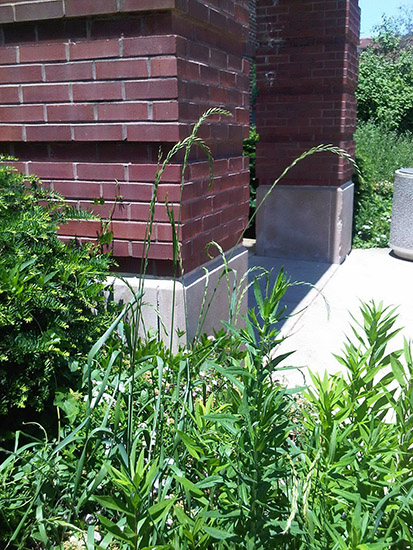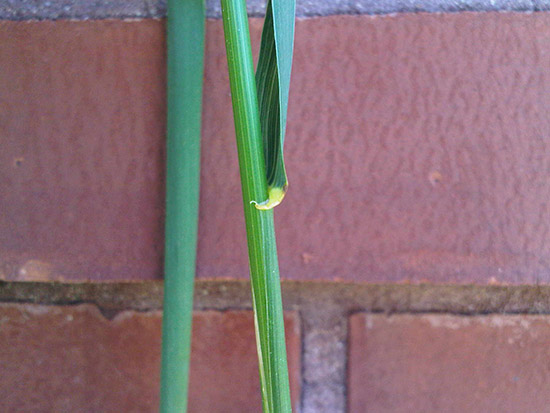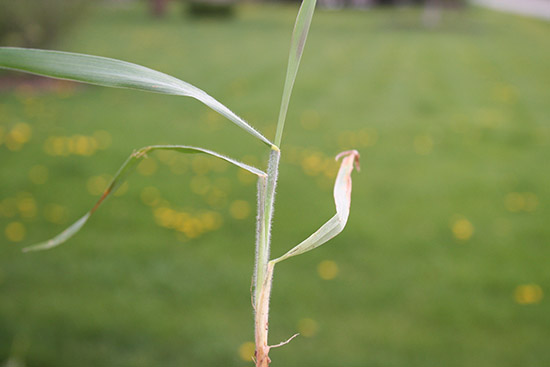Issue 9, June 21, 2013
Quackgrass - Also Known as Devils-grass and Some Other Not So Nice Names
This morning I saw the tallest, thickest stand of quackgrass I think I’ve ever seen growing in a perennial landscape bed. Certainly, the cool temperatures with timely rains we’ve had this growing season have been very conducive to growth of this cool season, perennial, grassy weed. It can grow up to 4 feet and from what I saw, it was just about there. In fact, a quick prayer for the gardener might be in order. Has he or she simply given up on this weed? This weed may be choking out the perennials but let’s hope it hasn’t choked out the gardener.
Quackgrass (Elytrigia repens/Agropyron repens) can look very different depending on whether it is being kept mowed short or allowed to grow to its full potential. Here are general characteristics to aid in identification. The leaf blades are flat, dull green to light blue?green and taper to a pointed tip. Blades grow 1/8 to 1/2 inch wide and can grow 3 to 12 inches long. On the upper surface, the blades are smooth to rough, and may be sparsely hairy. However, on the lower surface, they are smooth. The sheaths can be hairy or smooth. Often, young plants will have hairy sheaths. The leaves have a very short (1/32-inch) membranous ligule. A key identifying feature of quackgrass is the claw-like, slender auricles that clasp the stem. This presence of these structures easily separates this plant from other grassy weeds like crabgrass, quackgrass, or various foxtail species.
This coarse-textured grass spreads aggressively by long-lived, slender, white rhizomes with sharp tips. And this, my friends, is how this plant has earned the name quick grass, devil’s-grass, and other not so nice names. The rhizomes can stretch out several feet long producing new roots and shoots every few inches or so. Pulling this plant often results in breakage of stems or rhizomes. Remaining stems and rhizomes in the soil will continue to grow. Adding insult to injury, quackgrass can also spread by seed. The seed heads are 2 to 6 inch long spikes that occur from late May to September.
Quackgrass thrives in well drained soils with slightly acidic pH. It favors thin lawns and other areas where there is little to no competition. It can be a serious management problem in lawns, landscapes, nurseries, and crop areas. To decrease populations of this weed in lawns, maintain turf density and health through proper culture. Low mowing and fertility maintenance may aid in decreasing populations. Turfgrass that grows faster will compete better with this weed. Turfgrass that grows darker will perhaps mask this dark colored weed as well.
Apply herbicides in the spring and fall when this plant is actively growing.
We are getting into summer, but applications could still be made now if needed. Once temperatures rise, this weed should go dormant. Unfortunately, there are not any selective herbicides available for use in lawns. In these areas, fall applications would be best as seeding can then follow when temperatures are more conducive for turf seedling growth. In gardens, cultivation yields poor control due to the rhizomes. Spot or directed applications of glyphosate (RoundUp and others) may be used. Check after a week to see if a second application is in order. There are herbicides specific for killing grasses that may be tried such as sethoxydim (Hi-Yield Grass Killer and others) or fluazifop (Fusilade II and others). Read and follow all label directions very carefully. If chemical use is not an option, digging by hand may be effective but the entire plant must be removed. Plan to monitor the site and schedule future digging attempts.

Quackgrass can grow to 4 feet -- taller than surrounding ornamentals

Quackgrass seedhead

Clasping auricle (middle)

Young plants are often hairy

Quackgrass in a bed
Author:
Michelle Wiesbrook